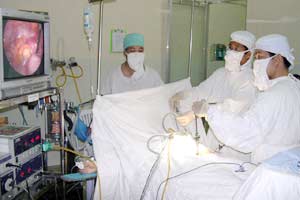“In Thailand, if a patient must undergo open surgery, they will ask the doctor to guarantee that laparoscopic surgery cannot be performed for their condition. If they later discover that it can be done elsewhere, they will sue the doctor for negligence,” stated Professor Nguyen Hoang Bac from Ho Chi Minh City University of Medicine and Pharmacy.
“This shows that laparoscopic surgery has become very popular and is the number one choice for both surgeons and patients today,” Professor Hoang Bac assessed.
 |
| A laparoscopic surgery at Binh Dan Hospital, Ho Chi Minh City (Photo: VNE) |
Previously, open surgery could lead to rectal cancer patients suffering from uncontrollable bleeding in the sacral area, experiencing aortic aneurysms that could rupture suddenly, or complications like uncontrollable hypertension when removing the adrenal gland… When these symptoms occurred, doctors could only watch patients die on the operating table without any means to save them, Professor Hoang Bac shared. However, with the application of laparoscopic surgery, these conditions can be resolved very safely and effectively. In some cases, patients did not lose a single drop of blood during the surgery.
In the past, doctors were always afraid of misdiagnosing patients presenting with appendicitis symptoms. “The rate of misdiagnosis of symptoms and stages in this condition is quite high,” Professor Hoang Bac noted. But with laparoscopy, doctors can accurately diagnose symptoms and disease stages. This timely decision to operate helps patients avoid many complications. Moreover, this method effectively manages cases of ruptured appendicitis, with laparoscopic diagnosis also helping to identify other conditions unrelated to the appendix. Notably, for obese patients, the surgeon must probe 10 cm to locate the nerve. “With open surgery, ‘overcoming’ a thick layer of fat to reach the operative site is indeed a significant challenge. But with laparoscopic instruments, this becomes simple, providing a sense of safety for both the surgeon and the patient,” Professor Hoang Bac explained.
According to him, laparoscopic surgery has become the “gold standard“, the optimal method for treating gallbladder stones (a very common condition in Vietnam). Patients undergo only three small incisions on the abdominal wall (almost scar-free) to remove stones. This method effectively controls the likelihood of stone remnants post-treatment, and patients can be discharged within two days. There is a 98% success rate based on actual treatment outcomes. However, in open surgery, 100% of patients are left with residual stones after treatment.
Laparoscopic surgery has also become the “gold standard” for splenectomy in cases of thrombocytopenia. This procedure ensures that patients do not need to return for medication after treatment, with a 100% success rate. Furthermore, laparoscopic surgery resolves intestinal obstructions post-surgery, as well as abdominal adhesions or partial obstructions that repeatedly occur.
Doctors also use laparoscopy to remove large uterine fibroids through a very small incision. This is done by using a small drill to gradually extract tissue samples without needing to enlarge the incision. Laparoscopic surgery also allows for procedures that are very challenging to perform with open surgery. Currently, laparoscopic techniques are applied in almost all specialties, such as cholecystectomy, treatment of common bile duct stones, liver cystectomy, management of hiatal hernias and esophageal hernias, gastric surgeries, intragastric surgeries, gastrojejunostomy, Taylor-type vagotomy, gastrostomy, splenectomy for blood disorders, appendectomy, gastric perforation repair, pancreaticoduodenal anastomosis, managing adhesions and treating intestinal obstructions and partial obstructions, thoracic sympathectomy, cryptorchidism surgery, varicocelectomy, liver cystectomy, colectomy, and treating rectal prolapse. In summary, according to Professor Hoang Bac, anything related to surgery can be performed laparoscopically.
The ability to perform these procedures is due to laparoscopic surgery creating a larger operative space, better lighting, and clearer images that allow for more meticulous operations, resulting in minimal immune and nutritional disturbances. Patients increasingly prefer laparoscopic surgery as it addresses all the shortcomings of open surgery, such as very small and short incisions of less than 5 mm, less pain, no complications, quick recovery, earlier return to daily activities, and meeting aesthetic requirements.
However, performing laparoscopic surgery requires facilities to have adequate personnel and supporting equipment. “Surgeons who perform laparoscopic procedures must first be skilled in open surgery. Additionally, they need to be equipped with modern specialized devices and supported by a skilled technical team to operate and maintain these devices,” Professor Bac outlined the conditions necessary to perform laparoscopic surgery. “Therefore, not every facility in Vietnam can currently perform laparoscopic surgeries.”
There are still some surgeries that are too complex and require open techniques. However, with the continuous advancement of technology and medicine, the future of laparoscopic surgery will gradually replace open surgery in all cases.
My Lan



















































